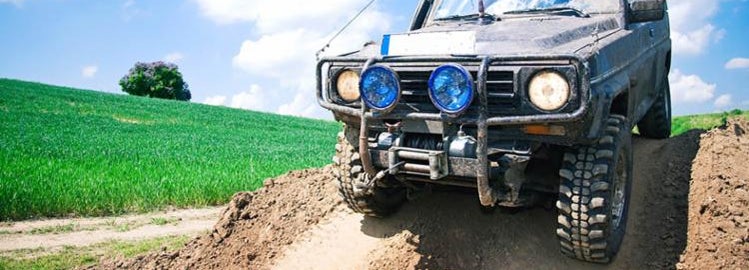Tire Basics for the Off-Road Enthusiast

For off-road enthusiasts, purchasing tires can be quite tricky. The choice is dependent on what type of driving the vehicle is going to be used for. Both tire and thread construction should be considered in making a decision as to the tire that will suit the needs of the owner. Just make sure you're covered with an affordable auto insurance policy.
Tire Construction
The first thing we will look at is tire construction. Tires are constructed in one of three ways.
Radial Ply
This type of casing is the best for highway use. The casing is generally made of polyester and gives a smooth ride. The tire is steel-belted, which helps hold the thread flat. The disadvantage with this type of casing is that the sidewalls are fairly weak and don’t resist impact very well. Another disadvantage is that the steel belts are fairly stiff and give a bad ride on road imperfections such as corrugations.
Bias Ply
These tires have stronger construction than radials and have the same strength in the sidewalls as the threads. They also conform well to road imperfections. The casing is generally made of nylon. This type of tire was originally used for trail running and is still the best for off-road use, due to the flex in the thread.
This flex means a smoother ride on off-road tracks. The disadvantage with bias ply is on blacktop: They have less directional stability than radials and tend to wear faster.
Bias Belted
Bias belted tires are the best compromise for wheelers who do about 60% percent of their driving on the road. These tires have fiberglass or steel belting around the thread of the tire. This gives a ride characteristic of the radial on the road, but gives a stiff ride off-road unless used on a heavy vehicle.
When purchasing a tire, one should check the thread conformability by pressing down on the thread of the unmounted tire with a finger. Keep in mind, though, that the softer the thread, the faster it will wear. The stiffer thread will last longer, but will give a stiffer ride on off-road tracks.
Thread Pattern
When choosing a thread pattern, the size and weight of the vehicle has to be a consideration. Thread void ratio (the amount of open space between the thread blocks) will determine the amount of pressure per square inch the tire can put on the ground. A high void ratio will put more contact pressure on a smaller amount of rubber, given the vehicle’s weight. The same void ratio on a larger tire will decrease the contact pressure from the same vehicle.
Hence a lighter vehicle, with the same tires, will give less contact pressure than a heavier vehicle. Now, imagine a lighter four-by with a wide, low void ratio tire. Contact pressure, in this case, would be low, giving less traction on any surface. Owners of lighter off-road vehicles should not overlook this potential problem.
All-Terrain vs. Mud vs. Highway
This area is easily understood by off-road newbies. When buying a tire, these are the categories in which tires are presented for purchase.
- Highway tires have the least aggressive thread of the trio. They are excellent for highway use, as they have the best ride of the bunch. Highway terrain tires also have excellent mileage and some manufacturers even give mileage guarantees. However, their off-road performance suffers due to having the least traction, and they puncture fairly easily compared to the other types of tires.
- Mud terrain tires have the most aggressive thread pattern. They are excellent for off-road use, with their ability to self-clean in mud. Mud terrain tires once had a reputation for being noisy and wearing quickly, but new technologies have enabled these tires to be quieter and last longer than their predecessors. They are the most puncture-resistant tires of the three. They are also the most expensive, and if the prospective buyer plans to use the vehicle exclusively on blacktop, highway tires are the best bet, as they are more cost effective and will give better mileage and a better ride.
- All-terrain tires are the best compromise when it comes to on-road vs. off-road driving. They are more aggressive and more puncture-resistant than highway tires, but quieter and give a better ride than mud tires. With current advancements in tire technology, the difference between some all-terrain tires and mud tires has become much smaller. Some mud tires could be classified as all-terrain, since they are less noisy and have more mileage than the mud tires of the past, while some all-terrains have very aggressive threads while maintaining the advantages of a tire in this segment.
As you can see, purchasing tires for your four-wheel drive vehicle is far from being a hit-and-miss affair, if you are armed with the necessary knowledge. Purchasing the right tire for your needs will enable you to enjoy longer tire life and have the right traction for the type of road traversed most often. You should also consider an affordable car insurance policy.
